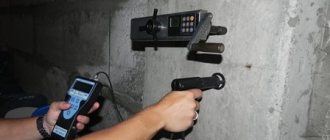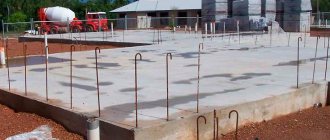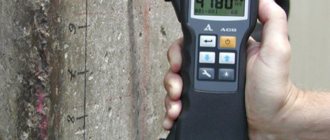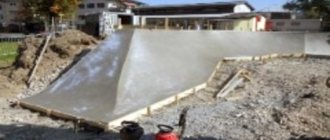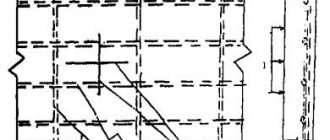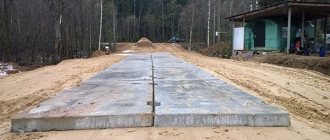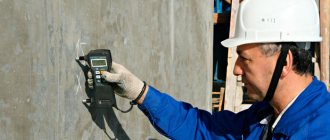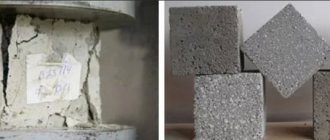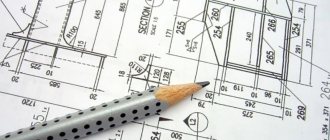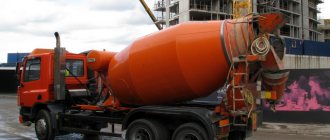Theoretical information
Concrete is a building stone material of artificial origin, which is obtained through the hardening process of a properly selected compacted mixture of binders (cement, sand, crushed stone, water, and other aggregates). To increase the ability to withstand aggressive environments and enhance strength properties, special additives are used. The mixture of all these components before it hardens is called a mixture.
The stone base is formed by sand and crushed stone. After adding water to the mixture, a cement paste is formed, which fills the gaps between sand and crushed stone, enveloping them, and initially performs the function of a lubricant for aggregates, with the help of which the mixture becomes mobile (fluid). During the curing process, the grains bind the aggregates together to form a man-made monolithic stone called concrete. When combined with steel reinforcement, the resulting structure is called reinforced concrete.
Unbrakable control
The components must be clean, without impurities, and the water must be fresh.
This is a type of control of parameters and properties that should not lead to a violation of the suitability of concrete for subsequent operation or use. Non-destructive inspection is of particular importance during the construction and operation of critical components, structures or products.
When determining strength indicators using non-destructive testing methods, it is very important to understand that the results of all these methods are based on indirect characteristics. It is impossible to give preference to one method or another; they all have their pros, cons and limitations of use. For a more accurate determination, the laboratory must be equipped with non-destructive testing equipment, including all control methods. The initial stage of the building’s existence is characterized by control over compliance of the linear dimensions with the project and the absence of significant deviations from the norms and rules of construction.
For this use:
- all kinds of rulers;
- bore gauges;
- roulette;
- staples;
- calipers;
- microscopes;
- probes and other special equipment.
Protection circuit
Deviations of structures from permissible horizontal and vertical indicators are usually measured:
- level;
- theodolite;
- straight edge.
In already constructed buildings, the strength indicators of individual structural elements are usually determined by two methods.
- In one of them, the structure is loaded until the moment of its destruction, thus determining the maximum load-bearing capacity. But this method is very expensive and impractical from an economic point of view.
- Non-destructive methods, which involve the use of special instruments to assess the condition of structures, are much more attractive and more convenient. Such cases involve processing the obtained results and values using special computer programs that make it possible to obtain the values of the final characteristics with sufficient accuracy.
The permissible error during testing is the most significant factor in determining methods and means of control and measurement. At the same time, ease of processing results and convenience in carrying out work are very important.
Non-destructive methods rely on indirect indicators:
- imprint;
- stress leading to partial (local) destruction of the structure;
- energy expended upon impact.
The most commonly used non-destructive testing methods for concrete and other building materials will be described in more detail below.
Non-destructive testing using physical methods
The category of such methods includes technologies of acoustic influence and penetrating radiation. They provide an opportunity to judge the quality characteristics of a structure by its internal structure, since the speed of propagation of waves of elastic vibrations is measured directly through the material being tested.
The most commonly used device is to determine the strength of concrete using the ultrasonic method. It allows you to take readings without exerting mechanical impact on the structure. It is used to measure the speed of ultrasonic waves passing through a layer of concrete. In a through study, the sensors can be located on both sides, and in a surface study, on one side.
Ultrasound testing is considered the most informative and quite simple. It allows not only to evaluate the strength parameters, but also to find possible defects inside the layers. The device used has several operating modes, which are presented in the table.
| Mode | Description |
| Calibration | Allows you to adapt the device to the characteristics of concrete. Transverse waves inside the hardened mixture are measured, and important parameters necessary for taking high-quality images of the structure of the mass are determined. |
| Review | Makes it possible to quickly study the internal structure of a structure. The thickness is measured, defects or objects located in the array (fittings, pipes, cables) are detected. |
| Collection | Ultrasound data is collected. Recording is done in various positions. Scanning is carried out in the form of a strip (or a special tape). |
| View | Used to analyze data over a long period of time. In this case, all types of images are present on the screen. They can be displayed one by one or all at once. |
An ultrasonic concrete strength meter allows you to carry out numerous tests repeatedly, constantly monitoring changes in parameters. The disadvantage is the error in the relationship between the acoustic characteristics and the basic parameters.
Options for local destruction
Such non-destructive methods for strength control are the most accurate, since they allow the use of a universal calibration relationship, which involves changing only two parameters:
Table of types of concrete
- the degree of fineness of the aggregate, which is taken equal to 1.0 if the size is less than 5.0 cm and 1.1 if the size is greater than 5.0 cm;
- type (light or heavy).
The method of tearing off with a chip and the method of chipping a structural rib are characterized by recording the forces required to chip a part of a structural rib or local destruction of concrete while pulling the anchor structure out of it.
The chipping method is the only method of non-destructive strength testing for which the standards provide calibration dependencies. This method is the most accurate, but is due to the large labor costs required for drilling holes and installing anchors. The main disadvantage of this method is that it cannot be used in structures with dense reinforcement and thin walls.
In structures with dense reinforcement, when the chipping method and the rib spalling method cannot be used, the strength of concrete can be determined by the method of tearing off metal disks. It is quite accurate, but much less labor-intensive compared to the chipping method. The disadvantages of the method include the requirement to glue the discs several hours before the start of the tests. The time depends on the conditions and the glue used.
The method of chopping a structural rib is usually used to determine the strength of linear elements (columns, piles, beams, crossbars, lintels). To begin testing, preliminary preparatory work is required. Moreover, in case of violations of the protective layer and the protective layer having a thickness of less than 2.0 cm, the method is unacceptable.
Layout of foam concrete.
The method of tearing off metal disks is characterized by recording the stresses required for local concrete destruction during the tearing off of a steel disk from its surface, equal to the forces expended on tearing, divided by the projected area of the concrete surface being torn off onto the plane of the disk. In modern life this method is used very rarely.
Non-destructive technologies for monitoring concrete strength
Testing concrete using a non-destructive method involves assessing the condition of concrete structures through the analysis of various factors that affect strength, diameter of reinforcement, thickness of the protective layer, humidity, thermal conductivity, adhesion, etc. This type of research is especially relevant in cases where the characteristics of the concrete monolith and reinforcement are not known, but the scope of control is large.
This group of methods makes it possible to carry out research both in the laboratory and directly on the construction site and even during operation.
The main advantages of non-destructive testing:
Maintaining the integrity of the structure being tested. Possibility to avoid the need to organize laboratory assessment directly at the construction site. Full preservation of the operational properties of buildings and structures. Quite a wide scope of application.
Despite the fact that there are a lot of methods and methods for studying liquid and hardened concrete, there are also many characteristics, the main property and indicator is strength. The scope of application and operating conditions, reliability and durability of the structure depend on strength. So, for example, if the concrete is frost-resistant and plastic when poured, with the best versatile characteristics, but not strong enough to withstand the design loads, the building will simply collapse.
Strength is a determining factor of concrete and must be checked very carefully. All tests are carried out on the basis of GOSTs: 22690-2015, 17624-2012 (inspection procedure), 18105-2010 (general inspection rules are described). The use of non-destructive methods involves the use of mechanical methods (indentation, chipping, tearing, impact) and ultrasonic examination.
The study of non-destructive testing of concrete is carried out according to a schedule, necessarily at the age established by the project or as necessary. Thanks to the research, it is possible to evaluate the tempering/stripping strength and compare the obtained real indicators of the material properties with the passport ones.
Non-destructive testing methods used:
- Direct (local destruction) - chipping of an edge, tearing off with chipping, tearing off a metal disk. Indirect - elastic rebound, shock impulse, the use of plastic deformation, as well as the ultrasound method.
Local destruction conventionally refers to non-destructive methods. Their main advantage is the reliability and accuracy of the results. Tests are regulated by GOST 22690-2015.
Direct non-destructive methods for monitoring the strength of concrete:
Separation with chipping - the force required to destroy concrete in the process of tearing out an anchor is assessed. Among the advantages, it is worth noting the high level of accuracy, the presence of calibration dependencies in accordance with GOST, among the disadvantages - the inability to use for assessing densely reinforced and thin-walled structures, and labor intensity. Edge shearing – measures the force required to shear concrete at the corner of a structure. Typically, the method is used to determine the strength of linear structures (square columns, piles, support beams). The main advantages of the method are ease of implementation, no need for preliminary preparation, disadvantages - it is not applicable to concrete with a layer of more than 2 centimeters and damaged monolith. Separation of a metal disk - the force that destroys concrete at the moment of separation of a metal disk from it is recorded. The method was often used in Soviet times, but today it is practically not used due to restrictions in terms of temperature conditions. Advantages: you can check densely reinforced structures, low level of labor intensity, disadvantages - the need for preliminary preparation (discs are glued to the surface of the concrete monolith 3-24 hours before the start of the test).
The main disadvantages of local destruction for measuring the strength of concrete are the need to calculate the depth of the reinforcement, high labor intensity, partial damage to the surface of the monolith, which can (albeit insignificantly) affect the performance properties.
Shock-impulse methods are more productive, but they only test the top layer of concrete 25-30 millimeters thick, so their use is limited. The surface must be cleaned, the damaged layer must be removed, and the graduated dependences of the devices must be brought into full compliance with the actual strength of the monolith according to the results of tests in the press of control batches.
Currently reading: Expanded clay concrete for building a private house
To measure the strength of concrete, the shock impulse method is often used - the most common option, which makes it possible to determine the class of concrete by performing studies at various angles to the surface, taking into account the elasticity and plasticity of the material.
The striker with a spherical striker, thanks to a spring, hits the surface of the concrete, while the impact energy is spent on its deformation, a crater appears (plastic deformations) and a reactive force (elastic deformations).
The electromechanical converter converts the mechanical energy of the executed blow into an electrical impulse; real results are obtained in units of determining compressive strength. For research, a Schmidt hammer is used.
Advantages of the method: simplicity, compact equipment, ability to set the class of the material, disadvantages - low accuracy due to determining the strength of the layer up to 5 centimeters.
Features of the elastic rebound method:
The tests use sclerometers - special spring hammers with spherical stamps. Due to the spring system, a free rebound after impact is realized. The path of the striker during rebound is recorded using a scale with an arrow. The strength of the material is determined by graduated curves that take into account the position of the hammer, because the magnitude of the rebound directly depends on the direction. The average research value is calculated based on the data of 5-10 measurements taken; the distance between impact sites should be at least 3 centimeters. The measurement range of the methods is 5-50 MPa, special instruments are used. Main advantages: simplicity/speed of research, ability to evaluate the strength of densely reinforced products. Disadvantages: determination of concrete strength is carried out in a surface layer 2-3 centimeters deep, checks need to be done often and a lot.
Testing the strength of concrete using the plastic deformation method is the cheapest method that determines the hardness of the concrete surface by measuring the mark left by a steel rod/ball that is built into a hammer. The hammer is placed in a perpendicular plane to the surface of the monolith and a couple of blows are made. The imprints on the concrete and the striker are measured. The obtained data is recorded, the average value is sought, and the characteristics of the concrete surface are determined from the resulting ratio of the sizes of the prints.
A device for research using the method of plastic deformation works by indenting a stamp with impact or static pressure. Static pressure devices are rarely used; impact devices (spring/hand hammers, pendulum devices with a disk/ball stamp) are more often used.
The following requirements are put forward: the diameter of the ball is at least 1 centimeter, the hardness of the steel of the dies is at least HRC60, the disk is at least 1 millimeter thick, the impact energy is 125 N or more. The method is simple, suitable for densely reinforced structures, fast, but is used to determine the strength of concrete of a maximum grade of M500.
In addition, there are other non-destructive testing methods - infrared, acoustic, vibration, electric potential method, etc. But they are used less frequently; shock impulse, tear-off with chipping, and ultrasound are considered basic.
The most difficult is considered to be the control of structures that are exposed to aggressive environments (chemical in the form of acids, salts, oils, thermal in the format of high/low temperatures, atmospheric - carbonization of the top layer).
When conducting an examination, by tapping and visually, by wetting with a phenolphthalein solution, they look for a layer with a damaged structure, remove it in the control area, and clean it with sandpaper. Then the strength is determined by sampling or local destruction methods. In the case of using ultrasonic and shock-pulse devices, the surface roughness of the monolith should be a maximum of Ra 25.
Impact methods
One of the most common methods of non-destructive testing of concrete strength is the impact pulse method.
This method records the impact energy that occurs at the moment the striker hits the concrete surface.
The equipment used in this method is characterized by relatively low weight and volume of space occupied. Yes, and determining the strength of concrete using the shock pulse method is quite simple. All results are expressed in the same units as compressive strength. According to the measurements, the class of concrete is also determined, strength is measured at different angles to the plane of the object, and the results are transferred to a computer.
Koshkarov's hammer is one of the methods for determining the strength of concrete.
Shock pulses are low-energy waves resulting from impact, which are generated by bearings, rolling due to changes in pressure and impact in the rolling zone during the operation of the bearings and propagate in the bearing elements, bearing mechanism assembly and parts in contact with it.
Using the shock pulse method has the following main functions:
- advance warnings about changes in bearing lubrication conditions to carry out lubricant replacement work according to its actual condition;
- advance warnings about changes in the operation of bearings due to the influence of various external factors in order to take measures to eliminate them in a timely manner (for example, imbalance, overloads, etc.);
- advance warnings about defects occurring in bearings in order to carry out work on their timely replacement;
- minimizing equipment downtime;
- minimizing risks associated with equipment failures. Ensuring reliable operation.
The springback method is the amount of rebound resulting from the impact of the impactor on the concrete surface. The Schmidt sclerometer and its various analogues are the most common instruments for testing with this method. Measuring the surface hardness of a concrete structure is the basis of the elastic rebound method and the plastic deformation method.
Initially, the hardness of metals was determined by the elastic rebound method. Tests are carried out using instruments called sclerometers, which are spring-type hammers with stamps in the form of a sphere. The spring system of the hammer does not prevent the hammer from freely rebounding after impact with a concrete surface or with a steel plate pressed against the concrete. A scale with an arrow on the device records the path of the striker during its rebound. The hammer impact force must be no less than 0.75 Nm, the radius of the spherical stamp at the end of the hammer must be no less than 5 mm. Every 500 blows the device is calibrated (checked).
As the test progresses, after each impact a measurement is taken according to the instrument scale (the accuracy should be one division). The result is recorded in a special work log. The requirements for the preparation of test sites (location, number of impact sites and experiments for constructing calibration curves) are identical to the requirements of the plastic deformation method.
Diagram of the destruction of a concrete beam.
The plastic deformation method is characterized by measuring the imprint left on the concrete after hitting it with a steel ball. This method of measuring strength is already outdated, but it is still used today, since expensive equipment is not required for testing.
The Kashkarov hammer is the most widely used for carrying out such tests. The operating principle is relatively simple. The hammer is equipped with a special removable metal rod, which has a certain already known strength. This hammer is used to hit a concrete surface. The impact marks on the rod and concrete are then measured using an angular scale. The strength of concrete is calculated by the ratio of the size of the prints.
Devices for determining the strength of concrete by plastic deformation are based on the effect of pressing a stamp into a concrete surface upon impact or static pressure of a certain force. Their use is limited. Impact devices are hand or spring hammers with a stamp in the form of a sphere (ball) and pendulum devices with a stamp in the form of a ball or disk.
Instrument stamps must be:
- hardness not less than HRC60;
- roughness Ra less than 0.32 microns. Maximum stamp wear – up to 5 microns;
- with a ball diameter of not less than 10 mm;
- the impact force must be at least 125 Ncm;
- the thickness of the disk is not less than 1 mm.
Methods for determining the strength of concrete
The strength of concrete can be determined in Russia only taking into account the standards established by GOST 18105-2010. The classification of methods used involves division into three subgroups.
- Destructive. In this case, concrete testing is carried out using control samples that are subjected to hardening under the same conditions as the structure, or that are removed directly from the concrete monolith after it reaches the required hardness indicators. These methods for determining the strength of concrete are considered the most accurate.
- Non-destructive indirect. This category includes ultrasound examinations (according to GOST 17624-2012), elastic rebound and shock pulse methods (GOST 22690-2015). It is important to note that these methods are so named because strength is assessed indirectly, through another parameter, by measuring, for example, the speed of ultrasound, and from it calculating the strength based on experimentally established dependencies. These methods for determining the strength of concrete without preliminary calibration can give an error of up to 30...50%; they cannot be used for calculations that require the reliability and accuracy of the obtained values without adjusting the results based on direct methods.
- Non-destructive straight. Testing of concrete in this case can be performed using one of two methods. The first of them involves tearing off a metal anchor embedded in concrete and measuring the load required for this, created using special equipment. The second (in this subgroup) method for determining the strength of concrete is based on measuring the force applied to shear a section of the outer edge of a concrete structure.
All measurements and tests that involve determining the strength of concrete involve the use of special tools and devices (concrete strength meters) to ensure the accuracy of the procedures performed. It is hardware measurements that provide the most reliable results and allow you to perform all the necessary manipulations in the shortest possible time and without stopping the construction processes and other work at the site.
Destructive methods
Any construction organization independently chooses control methods, but according to the requirements of today's SNiPs, destructive control must be carried out.
There are several ways to meet these requirements:
- The strength of concrete is determined on specially prepared samples. This method is used in the construction of prefabricated reinforced concrete structures and to control the yield of the finished concrete mixture at the construction site;
- strength measurements are obtained by cutting or cutting samples directly from the structure. Samples are taken at specific locations. In this case, depending on the stress state, the reduction in bearing capacity is taken into account. Sampling locations must be indicated in the design documentation or determined by the designers during the course of work;
- samples, so-called “cubes”, manufactured directly on the construction site according to specific technological regulations, are sent to the laboratory for testing. However, the production of concrete cubes (their hardening, storage) differs significantly from the actual conduct of concrete work (the degree of compaction and the curing time of the mixtures). These differences significantly reduce the accuracy of the results obtained by this method.
ONIX series instruments for determining the strength of concrete
Modern devices for determining the strength of concrete of the ONIX and PULSAR series, produced by , are focused on the use of all available methods for determining strength and are ideal for testing both in the laboratory and on the construction site using the rib chipping, tearing with chipping, ultrasonic velocity and shock pulse methods .
The use of high-precision technical means guarantees high speed and accuracy when recording strength parameters. This allows you to quickly obtain reliable results when determining the strength of concrete directly on the object under study without destroying the concrete monolith.
Paperwork
All results obtained during testing are recorded in a special journal, which must contain the following data:
- design name and batch number;
- type of strength being measured and its permissible value;
- type of concrete;
- test method (method), device, including serial number;
- average indicator of indirect strength characteristics and the corresponding indicator of concrete strength;
- correction factors used;
- test results to assess the strength of concrete;
- Full name, date and signature of the person who performed the tests.
Control methods
There are several methods for checking the quality of reinforced concrete concrete and each of them has both its advantages and some limitations in application.
Control of linear dimensions
A very simple method that consists of monitoring the linear dimensions of structures, as well as how well they correspond to permissible vertical and horizontal deviations. Using this method, measuring instruments (tape measure, ruler, caliper) and geodetic instruments (level and theodolite) are used.
Measuring strength and uniformity
To determine the strength of concrete, as well as the uniformity of its structure, the following methods are used:
- carry out local partial destruction (chipping off a small piece or edge, tearing off glued metal disks);
- produce artificial impacts: in this case, the impact force and the magnitude of the rebound are measured;
- ultrasound is used.
All non-destructive methods for monitoring the strength of concrete have proven themselves, but the results obtained using them have an error, since the accuracy of the measured readings depends on:
- product humidity;
- temperature;
- service life of concrete;
- concrete grades;
- conditions of pouring, compacting and setting;
- types of plasticizers.
Carrying out local destruction
When performing separation with chipping, the resistance of concrete is measured at the moment when its fragment is torn off using an anchor device. Using this method, fairly accurate results are obtained, but it is labor-intensive.
Important! This method cannot be used when working with structures that are too thin or with densely reinforced walls.
If it is necessary to diagnose the quality of piles, support columns or beams, then the rib chipping method is most often used. When using this method, there is no need to drill any holes or carry out additional preparatory measures.
Important! If the thickness of the protective layer is less than 20 mm, then using this method is not recommended.
The steel disc method involves tearing off previously glued metal discs (6÷12 hours before the start of the test: depends on the adhesive composition). This method is used if it is not possible to use the previous two due to various restrictions.
All three methods have several disadvantages:
- during the work, partial destruction of the wall occurs;
- Before starting work, it is necessary to determine at what depth the reinforcing bars are laid, as well as their number;
- The work varies in length and complexity.
Impact method
The most widely used diagnostic method, which measures the impact energy (at the moment when the impact element touches the concrete surface). Using this method allows you to obtain information about the class of concrete, its strength, elasticity; quality of material compaction and its homogeneity. Take several measurements and calculate the average.
The essence of the elastic rebound method is to measure the rebound length of the striker after it comes into contact with concrete. In this case, not only the strength of the material is measured, but also its hardness using a sclerometer.
Using the plastic deformation method, the size of the imprint that is formed as a result of the impact of a steel ball on the concrete surface is measured. This method is quite in demand (due to the low cost of the equipment), but is considered outdated.
Ultrasound diagnostic method
Using this method, the strength of the concrete of the entire structure is checked, as well as how well the concreting was done; determine the depth and size of cracks, and also identify the presence of any defects. Using special sensors, sounding is performed (surface and through). The disadvantage of this method is that it is not suitable for testing the strength of high-strength concrete.
